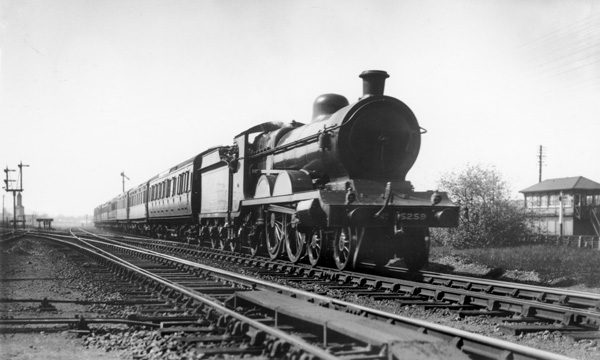GCR carriages
Revised
Gangwayed matchboard
Robinson's matchboard style emerged in 1910 with his open "Barnum" carriages (see separate topic). Corridor stock followed in 1911 with a more elegant profile. This topic now breaks down as follows:
Restaurant composite Open 3rd dining car 1st/3rd composite 1st/3rd brake composite
New additions placed here temporarily
Composite

A 60ft composite CK(4.3) No 34 from 1911 with a generous number of 1st class seats. Photo: Gorton negative, Doncaster Dwg Office, author's collection.
Click on the image for an enlargement

The Diagram for the matchboard CK, the only one. GCR running numbers were:
33, 34, 55, 65, 66, 69, 198 (=7)
With prefix "5" added by the LNER. No 33 was transferred to the NEA in late 1933.
Author's collection. Click on the image for an enlargement
In service

This picture tells quite a story for it is an example of a long distance Ordinary Passenger train captured at Handsworth behind Sheffield's C13 No 6062 with a Retford-Sheffield train that had probably been made up with non-gangwayed carriages among which there would been a good few lavatory stock, of which plenty had been built c1905 as 50' clerestories (and were also used on trains between Sheffield-Cleethorpes). However, there was a trend from the 1930s of replacing such stock with gangwayed carriages all of which had lavatories as a matter of course. On the NEA this was done by building new 61'6" stock but as this photograph shows, the GC Section did it by installing old gangwayed carriages, and possibly before the NEA. The mixture of carriages shows what the GC Section now had spare and could utilise:
CK |
1st/3rd |
60' |
ex-GCR matchboard |
BTK |
3rd brake |
50' |
ex-GCR Parker-style |
TK |
3rd |
58'6" |
ex-ECJS |
BTK |
3rd brake |
61'6 |
LNER D.176 |
Author's collection. Click on the image for an enlargement

A marvellous publicity picture of a Manchester-Marylebone train built in 1911, a -set with a BCK roof-boarded for Bradford-Huddersfield-Sheffield-Nottingham-Leicester-Marylebone, which would in service have been transferred at Sheffield. This was for the Down 10am from Marylebone. The loco in the distance appears to be 8F 4-6-0 No 1097 Immingham. The formation is:
BTK, CK, RC, BTK / BCK
in which the restaurant car is No 707, same as the portrait below, and it is not supported by a 3rd class dining car. Perhaps one was not available when the picture was taken? The BCK is No 54. All the lettering and numbering on these carriages was by brass castings and very elegant. Photo: negative Gorton Dwg Office, LNER Press Relations Office, author's collection.
Click on the image for an enlargement
Catering in the matchboard era
In 1911 Robinson broke the mould with catering on the GCR by introducing matchboard restaurant composites - which either ran alone, or were paired with a 3rd open dining car.
Restaurant composite
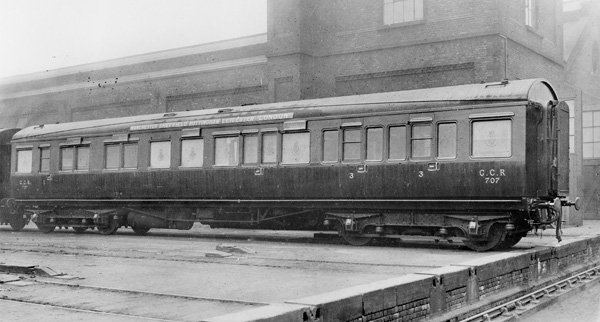
A 60ft restaurant composite to Diagram 5M2, the most numerous one built 1911-13, this being a 1911 example, No 707, captured at Dukinfield in slightly used condition. Either side of the kitchen were pairs of compartments for 1st and 3rd Class passengers, the higher Class with fixed tables, the lower class having them slid in as required. It was a pretty modest restaurant car and the whole batch was converted in 1935 to kitchen cars (5G4, LNER Code 5168). Photo: Gorton negative, Doncaster Dwg Office, author's collection.
Click on the image for an enlargement

The Diagram for GCR 5M2 (7 built, the most numerous version) shows the classic layout of the time with the kitchen in the middle and the two classes of catering on either side. However, the approach was getting old-fashioned even if differences between the classes extended beyond the leg room.
For the 3rd class there were two compartments - but no end vestibule, so external doors had to be provided (and facing in the corridor). Portable tables were slid in when required. The 1st class area also had compartments but there was more privacy by having no external doors: instead, a vestibule was provided alongside. The 1st class tables could thus be fixed.
It may all have been cosy and there was no interference from passing passengers but the trade-off was a certain crampedness and difficulty in serving passengers at the far end of the 7 foot long tables except by having the nearer diners pass everything across - a cumbersome procedure. In addition, the 1st class lavatory was tiny.
Later developments - The note on the Diagram about conversion in 1935 to "Restaurant Cars" was actually into Kitchen Cars for use with excursions. The LNER had already replaced (RC+TO) catering with (RF+TO) in which the number of 1st class seats was raised from 12 > 18 and both catering carriages had an open layout that was less cramped and easier to serve. Gresley restaurant cars also had a staff compartment. Note how in the Robinson RC, one was amended (and perhaps the rest too?) by placing lockers under the seats of the 3rd class compartment nearest the kitchen, almost certainly for the staff. There was a limit to what could be done in such a design and one wonders if the kitchen staff was forced to place their personal belongings and overcoats in the guard's van? And if a passenger compartment was made available for them to relax in?
After conversion to Kitchen Cars, these carriages lasted many more years, until around 1960, in fact, but that's a separate story. Diagram: Author's collection.
Click on the image for an enlargement
3rd Open Dining Car
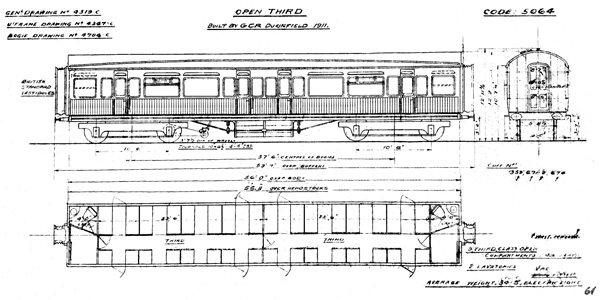
Robinson's TO of 1911 to GCR Diagram 5C5, LNER Code 5064, was built the year after the "Barnums" to a completely different and, on the GCR, novel format - the "Barnums" were 60' long with 64 seats, arranged 2:2 each side with tables in between, what became known as the "tourist" layout.
As can be seen, at 56' this TO was shorter and seated 48 passengers, arranged in the more spacious dining format of 2:1 each side. There were two bays separated by a partition with a door, possibly for smokers and non-smokers (the GCR Diagram did not say). There was no end vestibule with external doors and, instead, each bay had four external doors placed between the seats. Tables were not fitted and, like in the earlier restaurant cars, they were carried separately and set up for passengers as required. This carriage may appear to have been a novel development by Robinson but it was actually based on GNR carriages of 1899 and 1908 and the GCR design was quite a close copy.
The title on the GCR Diagram had originally been THIRD RESTAURANT but provision of portable tables instead of fixed ones was a throwback to the past which would not have made life easier for the staff. It's all the more surprising because Robinson had built 3rd class dining cars with fixed tables in 1906-7 (body panelling to the Parker style). The GCR seemed wedded to old-fashioned concepts in both the restaurant composite and these dining cars.
A detail on the Diagram is provision of toplights and Stones ventilators in two windows per side but note that the arrangement does not agree with the train photos or the view below. I've already mentioned that Diagrams were not as reliable as modellers tend to think. Diagram: Author's collection.
Click on the image for an enlargement
Finally, a view of this dining car as presented in the GCR Journal of 1911, in an article about a train built for the Newcastle-Bournemouth service, with apologies for the iffy quality:

Note how the handing of the windows with the Stones ventilation placed them diagonally opposite each other for maximum effect. I hope this is not getting too technical but 1911 was a year of many changes on the GCR under Robinson and a major turning point which set the style for the rest of the company's life.
Robinson also designed a version of 3rd Open the same year with his normal glazing/ventilation but 60' long in which the four external doors in the centre of the carriage were replaced by a vestibule with two external doors. In both cases what had started as dining cars eventually became non-catering 3rd Opens and the example in the mid-1920s train behind B3 6164 (above) shows one in general service as a strengthener.
Click on the image for an enlargement
In service

11E (LNER D10) No 430 Purdon Viccars leaves Marylebone with an express for the north. The loco was built in 1913 and I would estimate a pre-Great War date for the picture, with recently built matchboard stock. The formation comprises 5 carriages with no through brake composite nor any strengtheners and may have been a weekdays or off-peak service for Manchester. Photo: C. Golder collection.
Click on the image for an enlargement of the image repaired

An enlargement of the carriages shows:
60' |
BTK |
3rd brake |
56' |
TO |
3rd open (dining) |
60' |
RC |
1st/3rd restaurant |
60' |
CK |
1st/3rd |
60' |
BTK |
3rd brake |
The last two are not very clear and I cannot elaborate any further. This 5-coach formation developed from the innovations of 1903-1910. After the Grouping; ex-GNR practices were introduced and the restaurant composites were converted into kitchen cars for use with excursions.
Click on the image for an enlargement
Brake composite
This design deserves its own section because it was used as a through carriage for a long time, often behind the loco. And there is a kit.
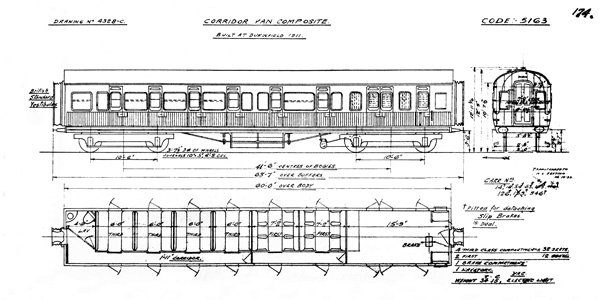
The Diagram for the BCK in the photo above, to GCR 5H7 and in 1938, Hollerith code No 5163. The GCR running numbers were: 14, 16, 54, 63, 105, 110, 126, 129, 846 (=9).
With prefix "5" added by the LNER. Note how, unlike LNER practice, guard's duckets were fitted on both sides. Two were dual braked of which No 105 was transferred to the NE Area on 10-12-33. These were long lived carriages and No 514 was recorded as having had its height checked by BR on 3-2-53. Redrawn from a scan by Rupert Brown, author's collection.
Click on the image for an enlargement

An unknown example of the same Diagram of BCK was captured still in varnished teak livery at Banbury General c.1950.
Click on the image for an enlargement
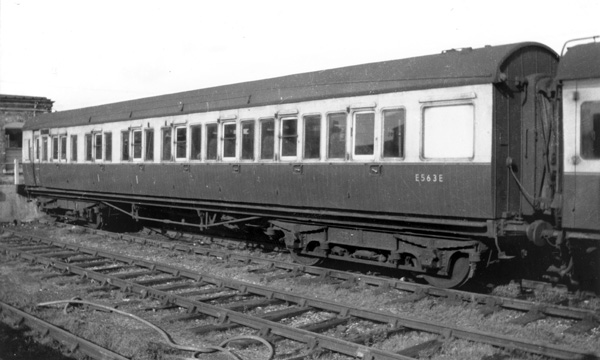
Another example, No E563E in BR carmine & cream livery in the mid-1950s, over forty years old and still in good shape.
Click on the image for an enlargement
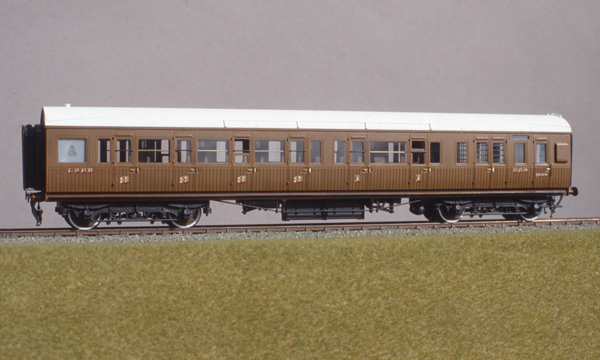
A model based on the Jidenco/Falcon Brass kit which I'll run as a separate topic later, along with some detail photographs of the 60ft underframe on an example that lasted long enough to be preserved.
Click on the image for an enlargement
The BCK In service

A scene from 1925 near Rugby with D10 "Director" No 5435 Sir Clement Royds and a Marylebone express. The BCK behind the tender is the same type as described above and is carrying the same roof boards for Bradford and Huddersfield as the publicity picture above. Author's collection.
Click on the image for an enlargement

Clear pictures of carriages in trains are rare and it's a shame that this view has been cropped at both edges. Sometime in the 1920s B3 No 6165 Valour is at Nottingham Victoria with an Up express when the formations were still made up with Robinson matchboard stock. Behind the tender is a 1st/3rd brake composite looking quite superb. Lens of Sutton.
Click on the image for an enlargement

A close-up of the BCK. The LNER livery is being carried with the number 110 changed to 5110.
Click on the image for an enlargement

Another matchboard BCK, this time at the head of the 2.20pm Manchester-Marylebone as it sets off from Sheffield Victoria on 14th September 1929 behind D10 No 5437 Prince George. The main formation has been modernised with Gresley carriages but for the through coach from Barnsley behind the tender, a matchboard BCK was still being provided. A marvellous example of real life provision of carriages and that change came slowly. It's possible that the picture above with Valour at Nottingham Vic also captured the 2.20pm from Manchester and the same matchboard BCK. Photo: W.L. Good. Click on the image for an enlargement A marvellous picture which I have repaired and described, leaving the photographer's tilt because correcting it would lose detail and ambience. D9 4-4-0 No 5112 (SHE) stands at Hull Paragon in the early- to mid-1930s.with the "Barry" through portion of the "Ports to Ports" express. It's the same type of matchboard BCK as described above, strengthened by a Gresley 61'6" TK. The working is described in the book under "Cross Country Expresses, The "Ports to Ports", pp.99-103. Photo: L.R. Peters collection. Click on the image for an enlargement Near Neasden on the final approach to Marylebone, C4 No 5259 has the morning 10am express from Bradford. The composition of this train changed along the way and the carriage behind the loco was a timetabled strengthener added at Sheffield, actually the return working of the BCK in the overnight newspaper train, the 2.32am. This carriage conveyed many a late-night traveller and resulted in stirring descriptions of that train's battle with the schedule. Photo: Author's collection. Click on the image for an enlargement Entering Leicester Central with an Up express, which what may be another capture of the 2.20pm Manchester-Marylebone with the BCK from Barnsley behind the tender. In charge is "Improved Director" D11 No 5509 Prince of Wales. The date appears to be early 1930s and similar to the view of the same train behind D10 No 5437 Prince George when LNER 61'6" Gresleys had been used to modernise the train, except for the matchboard BCK. Photo: Author's collection. Click on the image for an enlargement GCR London Extension - expresses: are here.
